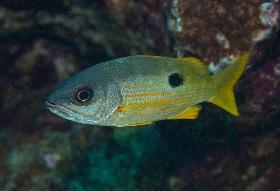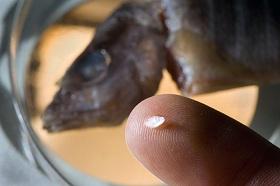River subbasins more depleted than
official figures show
09 April 2024
Published online 27 September 2012

Understanding the movements of fish as they grow to maturity could help scientists identify and manage the fragile habitats that fish rely on in early life, a new study suggests.
Researchers examined the inner ear structures, or otoliths, of Red Sea snapper to determine their diet during the juvenile phase. Otoliths contain small amounts of proteins, the amino acids of which are analysed by researchers using a technique called gas chromatography. The ratio of different amino acids can reveal the diet of the fish as it developed.
"Tropical seascapes, mangroves, seagrass beds and coral reefs all have different isotopic signatures, akin to chemical addresses," says Kelton McMahon, a marine biologist at King Abdullah University of Science and Technology (KAUST) and lead author of the study. "Those unique signatures get recorded in fish otoliths as the fish lives and feeds in those habitats."
The otoliths of a fish are formed from deposition of calcium carbonate in layers as the fish grows, similar to the formation of rings in a tree. Traces of the fish's diet found in otoliths indicate the age of the specimen when it inhabited a particular environment. Identifying and protecting the habitats where fish eat during their juvenile stage improves the likelihood that populations will thrive later.
"Maintaining the integrity of the [entire] seascape is critical, rather than simply protecting individual reefs within the seascape," says Simon Thorrold of the Woods Hole Oceanographic Institution (WHOI), and a co-author of the study, which was published in PNAS.
The team studied Ehrenberg's snapper (Lutjanus ehrenbergii), a common and commercially important fish in the Indo-West Pacific, including the Red Sea.

While juvenile snapper were known to rely on certain places for food and shelter, such as coastal mangroves, McMahon says that studies show large schools of adult Ehrenberg's snapper from the offshore reefs of Saudi Arabia come from both nearby and far flung juvenile nursery habitats.
"We don't know yet how these fish make such long distance migrations or why, but we can say that we have probably underestimated the migration capabilities of juvenile coral reef fish," McMahon adds. "This has important implications for connectivity of populations in the complex habitat mosaics of coral reef ecosystems."
The long distances that adult snappers travel mean that proper management requires not only protecting essential coral reefs and nursery grounds, but also the corridors along which the fish travel. Michael Berumen, a marine researcher at KAUST and the third author on the paper, is tracking individual fish tagged with acoustic transponders to follow their movements and record the underwater paths they take.
"We have no evidence that fish from certain juvenile habitats are remaining together once they reach reefs," Thorrold said. "We don't have enough data yet to answer behavioral questions."
Endangered snapper habitats threaten an important source of food for humans. Overfishing, pollution, tourism, drilling and construction all affect the interconnected world under the sea. The reefs of Saudi Arabia are still relatively unscathed, but signs of threats to marine life are emerging as large reef predators have been fished extensively and shrimp aquacultures increase.
"The Red Sea supports a thriving fishery that supplies a great deal of food and income to the local people," saysMcMahon. "In order to maintain that industry and protect the stunning coral reefs of the Red Sea, we must understand the underlying mechanisms that support such productive and diverse systems."
doi:10.1038/nmiddleeast.2012.141
Stay connected: